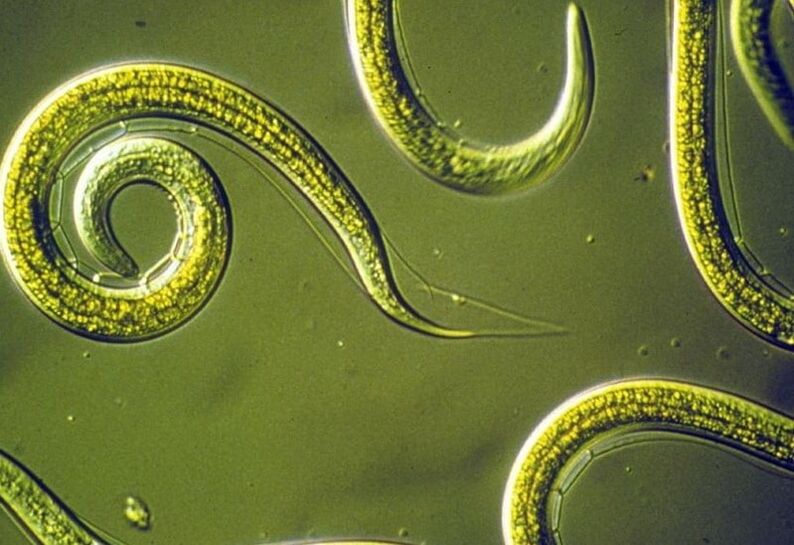Unfortunately, even in the modern, developed age, there is a risk of infection with worms. In order to be able to treat and prevent this phenomenon, it is necessary at least to be familiar with the main types of worms.
types of worms
You can find answers to your questions about what type of worm a person has in medical resources, which provide data on a wide variety of types. Of course, certain types are the most common. According to the classification, they can be divided into 3 main types. They are: round and tapeworms, and flukes.
roundworms
The first in the list of human worm types is for roundworms. They are also called nematodes. They get their name from the structure of the body because if you make a cross section of a person, you can see the resulting roundness. Although there are more than 20, 000 species of them in the world, only a few are usually found in humans.
The most common roundworms include:
- roundworms. These worms are quite large. They can reach half a meter in length. The width varies between 4-5 cm and the colour is usually pink, but in different cases it can be whiter or redder. These worms are mainly located in the small intestine, but in rare cases, they may also be located in the bile ducts. At the same time, the larvae easily move around the body through the blood. Their last stop is the lungs. It is here that their maturation has the most comfortable conditions, since this parasite is an anaerobic bacteria. As they become more vigorous, they move to the gut. Roundworms have a long lifespan, which can be 12-14 months. Outside the human body, these worms live in soil conditions and lay thousands of eggs every day.
- Pinworms. Most common in children, as infection may be caused by improper handwashing or product handwashing. They enter the body with a slightly lower frequency as dust particles. They are much smaller in size than roundworms. Males grow to 3 mm, females 13-14 mm. The color is completely white. Their favorite habitat is the initial part of the large intestine. The eggs are laid in the anus, which is closer to the anus. They also have a much shorter life expectancy than roundworms, only a few months.
- Trichinella. These medium-sized worms are only 4mm long and most commonly enter the body as part of infected meat. Larvae live in muscle tissue, mainly in the oculomotor nerve and chewing tissue, but adults prefer to locate in the gut. Trichinella is a danger to humans as it can be fatal without proper treatment.

tapeworm
Tapeworms are characterized by a flat body structure and complete absence of a gastrointestinal tract. Individuals can reach lengths of several meters, so they look like a long ribbon. They prefer to live in the gut or stomach tube. Among them are the following:
- Bovine tapeworm. This is one of the largest tapeworm species. The length of a person can reach 15-20 meters. The worms stick to the surface of the small intestine and begin to absorb the substances the body needs. Without proper diagnosis and treatment, he can live up to 10 years. Infection usually occurs through the consumption of contaminated, undercooked meat;
- Dwarf tapeworm. It gets its name from its small size, averaging 4-5mm. You can get this tapeworm from unclean vegetables or even dirty hands;
- Wide Ribbon. Another big view. It can grow up to 10 meters in length and is usually wider than other worms. The larvae enter the body with the infected fish and grow into adults in as little as 3. 5 weeks. Mainly live in the small intestine. life span of several decades;
- Echinococcus tapeworm. Small worms, usually no more than 5 mm in length. Infection occurs in infected animals: cats and dogs. The species differs in that individuals are not located in the gut, but in the lungs or liver. They are dangerous because they can cause cysts to form, which then require surgical removal.
These worms are very harmful to the body, so the sooner they are caught, the better.
lucky
Trematodes, like tapeworms, are flat parasites due to their body structure. They are also called liver worms because their main habitat is the liver and biliary tract. Their main types are:
- fluke. Also called cat fluke. It lives mostly in rivers and lakes, which means it enters the human body along with poorly handled, infected fish. Pets can act as carriers. Individuals are small, rarely reaching 12-13 mm. In the human body, they can live in absolutely any organ;
- Chinese or Eastern fluke. Its characteristic is that the body is transparent red, the body size is small, no more than 2. 5 cm, and it enters the human body, which is the same as the common fluke. More than 3, 500 eggs are laid per day;
- Fasiola. This is a larger flatworm that can be 5-7 cm in length. It survives only in freshwater conditions. It died in the salty spring. A person can become infected with fascioliasis by drinking contaminated raw water (for example, while taking a bath) and by eating plants. The risk is especially high if they are aquatic or wild species.
Liver flukes, despite their small size, can be dangerous to humans. In addition to standard symptoms, patients may have a fever.
the simplest creature
The simplest living things have existed on Earth for millions of years. To date, Science has read more than 14, 500 species. Like other parasites, their favorite habitats are soil, water in reservoirs, and of course, humans. They can stay on the surface of vegetables and fruits for a while, and using them often leads to infection.
In the vast majority of cases, when it comes to infecting a person with a protozoa, it means Giardia. Their dynamism is enviable. They can withstand even the harshest environmental conditions.
In their structure, they are characterized by the presence of four pairs of flagella and a special disc that performs a pumping function. Thanks to them, Giardia reliably attaches to the inner surface of the intestine and begins to parasitize.
show symptoms
The fact that worms appear in the human body can be understood by a large number of signs. But most of them were of a general nature, suggesting the presence of an inflammatory process. This can confuse the patient and force him to look for other causes of the disease.
Therefore, patients can take care of themselves during this period:
- fatigue, discomfort, fatigue;
- pale skin;
- dizziness and sometimes headache;
- Increased anxiety and irritability. In children, marked aggression can be seen;
- Sleep deteriorates. Usually worry about insomnia;
- joint pain, muscle pulling sensation;
- Increased salivation.

Fatigue is one of the signs that worms are present.
The following signs, reminiscent of allergic reactions or gastrointestinal disorders, may be misleading:
- yellowing of the skin;
- body rash;
- Bronchial asthma attack;
- Stool disorders: constipation or diarrhea;
- flatulence;
- nausea and vomiting;
- abdominal and flank pain;
- Body temperature rose slightly.
But the more typical symptoms in this case are: People most often begin to suspect that they have parasites:
- Weight loss for no apparent reason. At the same time, it has become very difficult to return the lost kilograms;
- anal itching;
- Bruxism. This phenomenon manifests itself in grinding teeth during sleep.
Although there are many signs of the presence of parasites in the body, sometimes the phenomenon is completely asymptomatic, so people may not be aware of it for months.
diagnosis
Identifying worms in the body is no easy task. In this case, the standard procedure is to check for ova in the stool. I must say that sometimes in order to detect worms in feces it may take 3 to 5 analyses.
How to identify certain types of worms, only a doctor knows. You can't do it yourself without test results. Depending on the symptoms, your doctor may prescribe the following tests:
- blood analysis. In this case, analyze the number of indicators such as protein and eosinophils;
- Anal scraping analysis;
- Analysis of vaginal scraping.
Additionally, in some cases additional measures may be required. like:
- sputum examination;
- study the composition of urine and bile;
- endoscopy;
- CT scan;
- Ultrasound program.
Once the parasite is identified, a doctor will develop a treatment plan.
treat
Self-treatment of parasites is not allowed. This is due to the following factors:
- These preparations contain different active substances, which means that they have an adverse effect on different types of worms;
- Some medicines only kill the larvae of the worms, not the adults;
- All medicines have some side effects.
In this regard, it is necessary to select drugs based on the results of diagnostic procedures.
Preparations may contain the following active ingredients:
- Mebendazole. It affects only worms of the genus Pinus;
- Diethylcarbamate. If the patient has filarial worms, prescribing a drug based on it;
- Levamisole. Has a broad scope of action. eliminate pinworms and roundworms, as well as other worms;
- Hydroxynaphthoic acid diphenol. Effective against roundworms;
- Albendazole. Necessary for the treatment of diseases caused by Echinococcus;
- Piperazine adipate. It is used to remove roundworms and pinworms from the body.
Traditional medicine is not sitting idly by in this matter. It offers a variety of methods that may not always completely remove the parasites from the body, but at least slow their reproduction and development.

Examples of such methods are as follows:
- pumpkin seeds. They are taken in pure form or in decoctions based on them;
- Watermelon seeds. Same goes for pumpkin;
- wormwood tincture;
- Tinctures of alcohol and wormwood juice;
- garlic;
- Tansy;
- Sandy Helichrysum.
It's important to note that before using folk methods, you should get your doctor's approval and, of course, rule out an allergic reaction to the ingredients used.
What are worms harmful to humans
Worms don't just live in the human body, they actually parasitize, take away useful substances, and suck out blood. The body experiences a state of intoxication. The result of long-term residence of worms in the human body can be the following negative consequences:
- weakened immune system;
- Invasion of the gastrointestinal tract. food indigestion, ulcers;
- the development of allergies;
- cyst formation;
- damage to the organs in which they live.
Don't forget that some types of parasites are very, very dangerous. Ignoring their presence can lead to the worst possible outcome.
prevention
The vast majority of people have encountered a worm at least once in their lifetime. Children are particularly affected by this. And it makes sense, in addition to their weaker immunity compared to adults, they often ignore hygiene rules.
In general, the methods that help reduce the risk of infection are not complicated. They mean:
- Follow personal hygiene rules. Hands should not only be rinsed but also thoroughly washed with soap;
- Vegetables, fruits and berries must be washed with plenty of water;
- Any meat: Livestock, poultry or fish should be washed before cooking. Heat treatment must also be thorough. If there is no confidence in the quality and safety of the meat, it is not worth the risk of cooking meat with blood;
- Children are regularly dewormed for prophylaxis. It is best to consult a doctor;
- In addition, livestock and pets also need to receive drug prophylaxis. At the same time, it makes no difference whether you live in the yard of a private house or in a room. If a dog or cat eats raw meat, then work must be done to prevent worms.
Such a procedure will help to avoid parasites for as long as possible.



























